A creamy and full flavoured Thai red curry recipe with tender chunks of chicken and oven roasted veggies. Make this simple Thai red curry in just 30 minutes and for a boost of flavour try it with homemade Thai red curry paste.
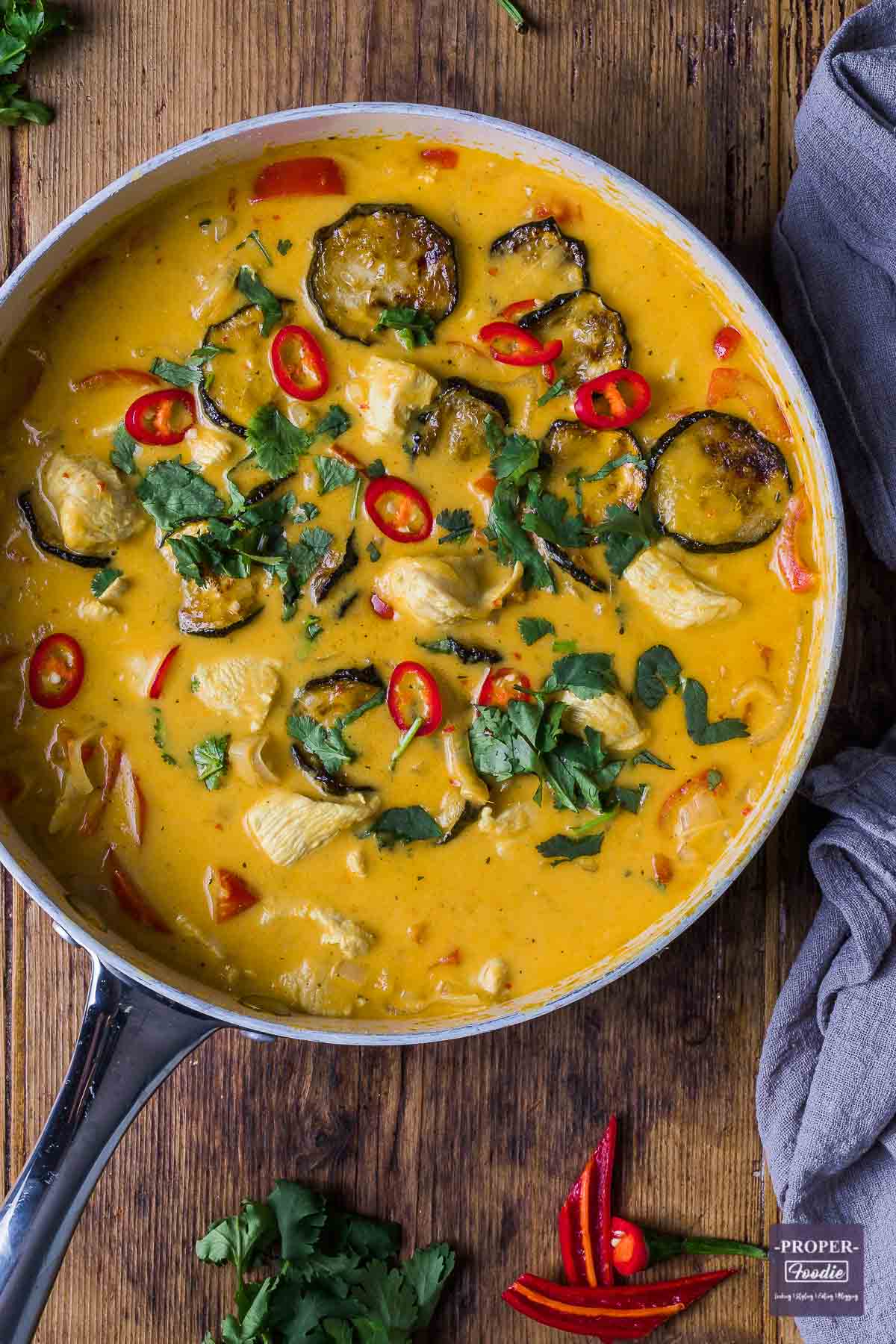
👩🏻🍳 Why make this recipe
A creamy and aromatic curry recipe that can be on the table in 30 minutes. Perfectly tender chicken coated in coconut curry sauce and finished with fiery chillies and coriander leaves.
Thai red curry is also great on a week night when you want something quick and tasty, that doesn't take too much effort. This particular recipe is a Thai chicken curry but feel free to replace the meat with your preferred choice or with extra vegetables.
This Thai red chicken curry recipe is adapted from the Thai recipes I made in 2012 in Thailand when attending the Siam Rice cookery school in Chang Mai, Northern Thailand. I've closely match ingredients where I can and used pre ground spices.
🥘 Ingredients
To make this easy Thai red curry recipe you will need:
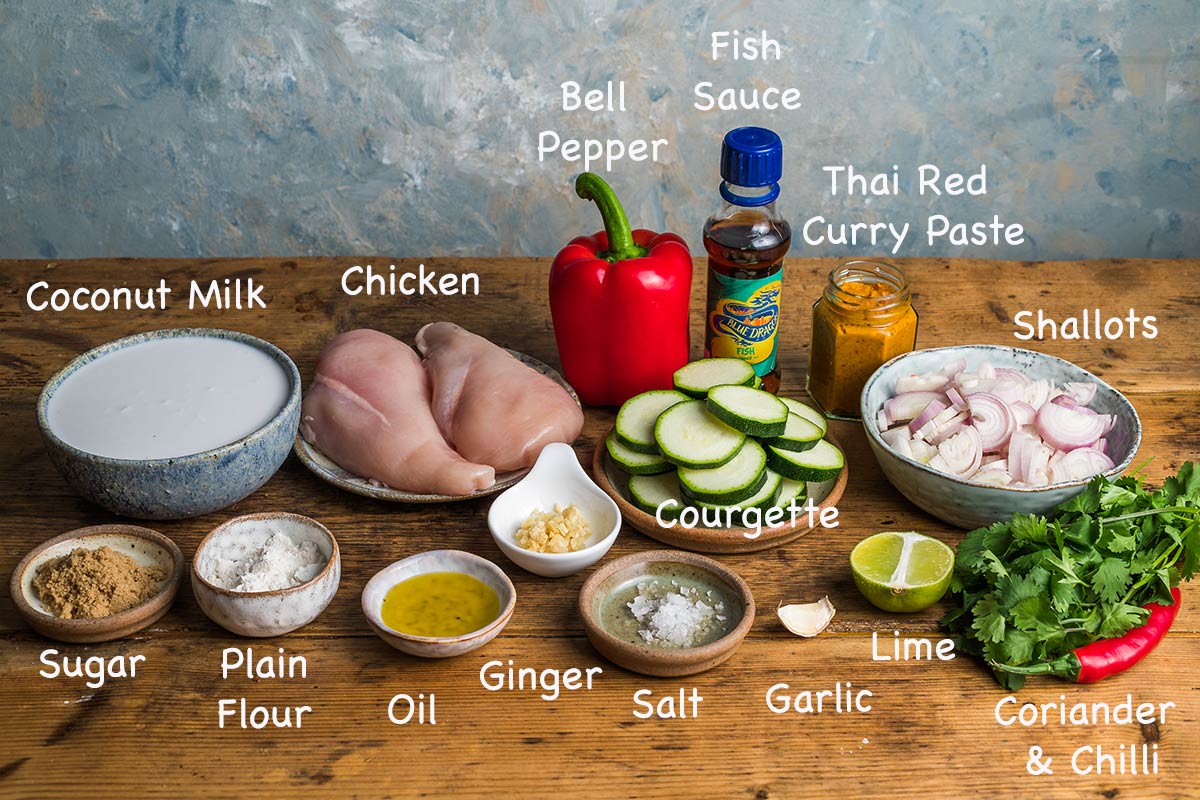
Ingredient notes
Shallots: The sweeter flavour of shallots compared to onions works really well in this creamy dish. However, you can swap for onion if you prefer.
Coconut milk: The best replacement for coconut milk in terms of consistency and flavour is cream. This can be a little heavy so you can also use yogurt or milk. If using milk I would recommend adding flour as well, as described in the recipe, to help keep the sauce thick.
Fish sauce: Fish sauce is the main seasoning ingredient in Thai cooking and completely transforms the dish. I highly recommend using fish sauce in this recipe for the best flavour. If you can't get hold of any or if you are making a vegetarian curry, you can substitute with soy sauce, Worcestershire sauce or seaweed paste.
Chicken: The chicken can be substitute for your preferred meat or fish. Or try a Thai green prawn curry. For a vegetarian option replace the chicken with extra veggies and remember to replace the fish sauce with either soy sauce, Worcestershire sauce or seaweed paste.
Ginger: Use fresh or jarred. Or for a more authentic taste use Thai ginger otherwise known as galangal (Kha).
Thai red curry paste: For best results I recommend making the Thai red curry paste yourself. However, if you don't have time to make the paste the best alternative is to buy a jar of pre-made paste. Bear in mind that the homemade paste can be made in advance and kept in the fridge for up to a week or frozen for up to 3 months.
Courgette: I love to add sweet and juicy roasted courgettes to this creamy Thai curry. However, this can be substituted for your preferred veg. Try with roasted aubergine or mushrooms for a similar bulk and texture. Or try with some crunchy greens like mangetout, tenderstem broccoli, or pak choi.
Flour: The flour is used in this recipe as a thickening agent. If you prefer a Thai red sauce with a thin consistency or if you are making a gluten free version then leave this out. See expert tips below for alternative ways to thicken a curry sauce.
Red Chilli: The red chilli is used as a topping to the curry and will add extra heat to the dish. Taste the chilli first so you have a rough idea of how much heat you're adding. The curry paste already contains chillies so if you're not a fan of too much heat then don't go crazy with the extra chillies. Use the smaller, thinner finger chillies for extra heat or use the larger red chillies for a milder flavour.
Fresh coriander: A suggested topping for extra flavour, but its optional.
🔪 Step by step instructions
- Pre heat the oven to 180°C (fan) (400°F). Slice the courgette into ¼ cm thick circles and place on a baking tray. Drizzle with oil and salt then bake in the centre of the oven for 20 minutes or until golden brown. Set to one side to cool.
- Next place a large, shallow pan on a medium heat. Add half tablespoon oil and the chopped garlic to the pan. Fry the garlic for 10-20 seconds to allow the flavour to be released. Next add the slice shallots and ginger and continue to cook until soft.
- Add the chicken to the pan and stir fry with the shallots until sealed all over. Transfer the chicken and shallots to a bowl and set to one side.
- Return the pan to the heat. Add 3 tablespoon of red curry paste (homemade or from a jar) and briefly cook for 30 seconds to allow the flavours to release.
- Next add the tin of coconut milk and mix well with the paste.
- Whilst the coconut milk is still relatively cool stir in the flour paste. Continue to heat and stir until the liquid heats up and gradually thickens. (Skip this step if making a gluten free version and see expert tips below for other ways to thicken the sauce).
- Once thickened add the chopped bell pepper and the pre cooked shallot and chicken mixture. Stir together well then add a splash of fish sauce, lime juice and 2 teaspoon of sugar to season.
- Before a final blast of heat, transfer the roasted courgettes to the pan and stir in. Allow the pan to heat gently and then simmer for couple of minutes until the chicken is cooked through.
- Serve with your choice of rice or naan bread (or both) and top with freshly sliced chillies and fresh coriander (optional).
💭 Expert tips
Extra spiciness: If you like your Thai red curry spicy then add chopped, fresh red chillies during cooking.
How to make curry sauce thicker: Use full fat coconut milk in the recipe. The reduced fat versions are more watery and so will ultimately thin out the sauce. Coconut milk can also lose its consistency when boiled rapidly over a prolonged period. So even though reducing a sauce does thicken it, rapidly boiling in this instance will not help. When making this recipe, ensure that the the finished Thai red curry is heated gently to a simmer before serving.
Other options for thickening the Thai red curry sauce include:
- Add full fat yogurt, but be aware that this will reduce the spiciness of the dish, so you may need to add more chillies at the same time. Only add yogurt right at the end of cooking - too much heat and the yogurt will curdle. Take the Thai red curry off the heat and stir in enough yogurt to reach your desired consistency.
- Instead of serving rice at the side, mix it directly into your curry whilst still in the pan. Then serve.
- If adding vegetables that release water during cooking (e.g. courgettes, mushrooms) roast these in the oven first and then mix into the finished curry.
- Add flour to the curry. To avoid flour lumps forming I usually mix 1 tablespoon of flour with a bit of water to form a paste. Then add the flour paste to the curry and mix well. For best results add the flour paste before its heated up to much. Then stir continually until the sauce thickens and the flour is 'cooked out'.
❓ Frequently asked questions
Out of all the Thai currys, Thai green curry is the hottest, despite the belief that Thai red curry is the hotter of the two. This is mainly down to the chillies used in the paste. Green chillies (particularly green birds eye chilli peppers) tend to be hotter than red. So whether the paste is hot or too spicy for you, is dependent on the ingredients used and the amounts. Try the paste before adding and if necessary balance out with yogurt or cream.
The main difference between Thai red and Thai green curry is the colour and the heat, both of which come from the type of paste used (Thai red curry paste or Thai green curry paste). Substituting one paste for other will ultimately dictate the type of curry you end up making.
2-3 tablespoon of paste is usually enough when making a curry for 2-4 people.
Once made, allow the Thai red curry to completely cool then transfer to a sealable container and keep in the fridge for 2 days or or in the freezer for up to 3 months. Defrost in the fridge overnight. Reheat in a pan or in the microwave until piping hot throughout.
Yes its gluten free, as long as you don't use the above flour option for thickening. But do always check the packets of the individual ingredients you are using. Generally the main ingredients in this curry are naturally gluten free.
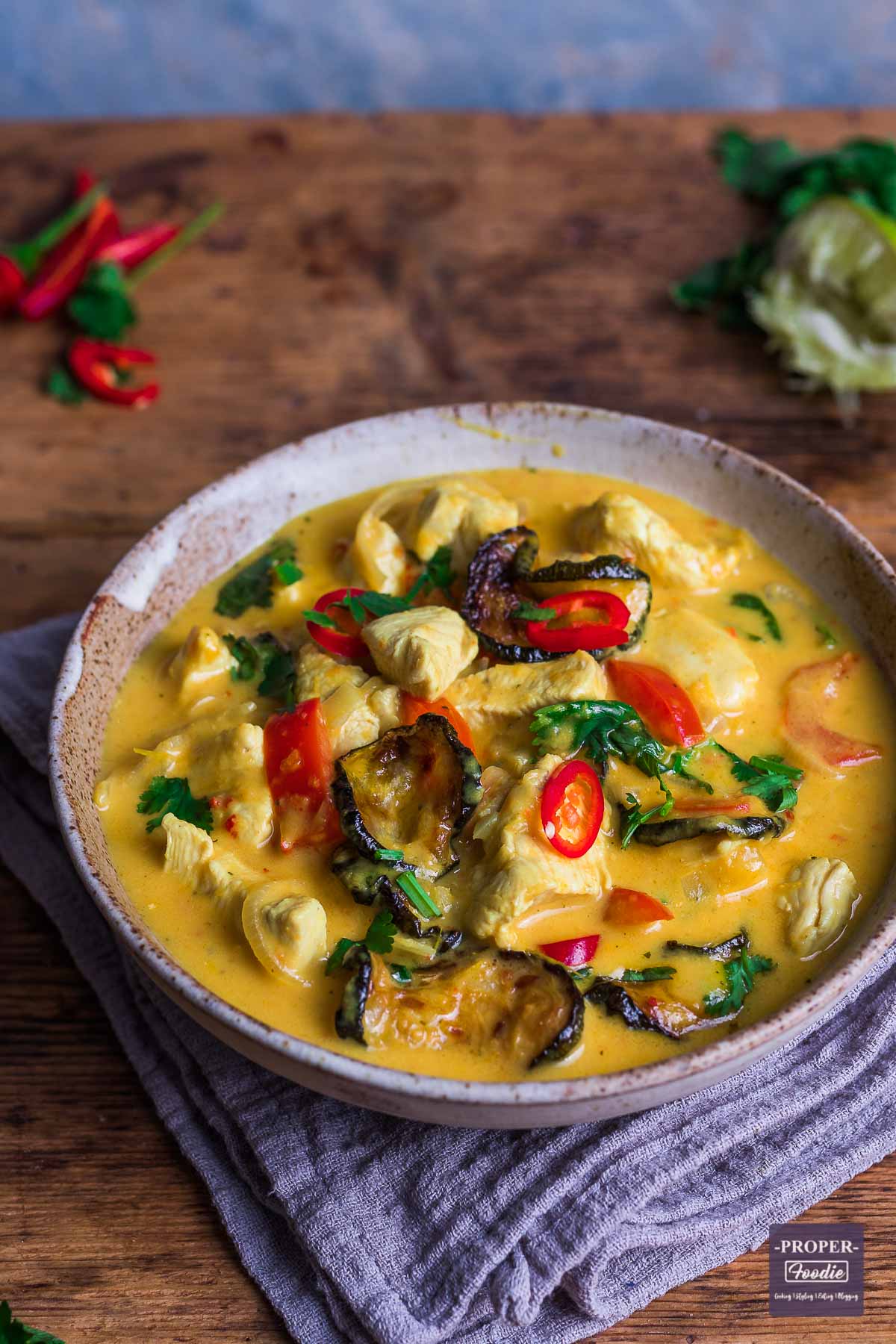
If you've tried this recipe, let me know what you think by leaving a star rating in the recipe card or comment section below. I always appreciate your feedback! You can also follow me on Pinterest, Facebook or Instagram or Sign up to my email list!
📖 Recipe
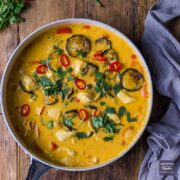
Thai Red Curry
Equipment
- Baking tray for roasting courgettes
- large pan for the curry
Ingredients
- 200 g courgette cut into circles ½ cm thick
- ½ tablespoon oil for courgettes
- Salt to season courgettes
- ½ tablespoon oil for garlic and shallots
- 1 clove finely chopped or minced garlic
- 150 g sliced shallots
- Small piece of finely chopped fresh ginger
- 2 chicken breast cut into bite sized chunks 260g
- 3 tablespoon red curry paste - homemade or jarred
- 400 ml tin of full fat coconut milk
- 1 medium red bell pepper roughly chopped
- 1 tablespoon plain flour mixed with a bit of cold water to form a paste
- Splash of fish sauce
- 2 teaspoon brown sugar or palm sugar
- ½ a lime juiced
- Fresh red chillies and coriander leaves for toppings optional
- Basmati rice or naan bread to serve optional
Instructions
- Start by preparing the courgettes. Pre heat the oven to 180°C (fan) (400°F). Slice the courgette into ¼ cm thick circles and place on a baking tray. Drizzle with oil and sprinkle with salt then bake in the centre of the oven for 20 minutes or until golden brown. Set to one side to cool.
- Next prepare the curry. Place a large, shallow pan on a medium heat. Add half tablespoon oil and the chopped garlic to the pan. Fry the garlic for 10-20 seconds to allow the flavour to be released. Next add the slice shallots and ginger and continue to cook until soft.
- Add the chicken to the pan and stir fry with the shallots until sealed all over. Transfer the chicken and shallots to a bowl and set to one side.
- Return the pan to the heat. Add 3 tablespoon of red curry paste (homemade or from a jar) and briefly cook for 30 seconds to allow the flavours to be released.
- Next add the whole tin of coconut milk and mix well with the paste.
- Whilst the coconut milk is still relatively cool stir in the flour paste. Continue to heat and stir until the liquid heats up and gradually thickens.
- Once thickened add the chopped bell pepper and the pre cooked shallot and chicken mixture. Stir together well then add a splash of fish sauce, lime juice and 2 teaspoon of sugar to season.
- Before a final blast of heat, transfer the roasted courgettes to the pan and stir in. Allow the pan to heat gently and then simmer for couple of minutes until the chicken is cooked through.
- Serve with your choice of rice or naan bread (or both) and top with freshly sliced chillies and fresh coriander (optional).
Video
Nutrition
Notes
- Add full fat yogurt, but be aware that this will reduce the spiciness of the dish, so you may need to add more chillies at the same time. Only add yogurt right at the end of cooking - too much heat and the yogurt will curdle. Take the Thai red curry off the heat and stir in enough yogurt to reach your desired consistency.
- Instead of serving rice at the side, mix it directly into your curry whilst still in the pan. Then serve.
- If adding vegetables that release water during cooking (e.g. courgettes, mushrooms) roast these in the oven first and then mix into the finished curry.
- Add flour to the curry. To avoid flour lumps forming I usually mix 1 tablespoon of flour with a bit of water to form a paste. Then add the flour paste to the curry and mix well. For best results add the flour paste before its heated up to much. Then stir continually until the sauce thickens and the flour is 'cooked out'.
This post was first published in April 2019. Updated in May 2021 with an improved recipe, new images, step by step photos and expert tips

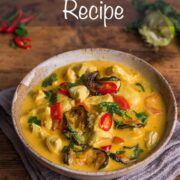
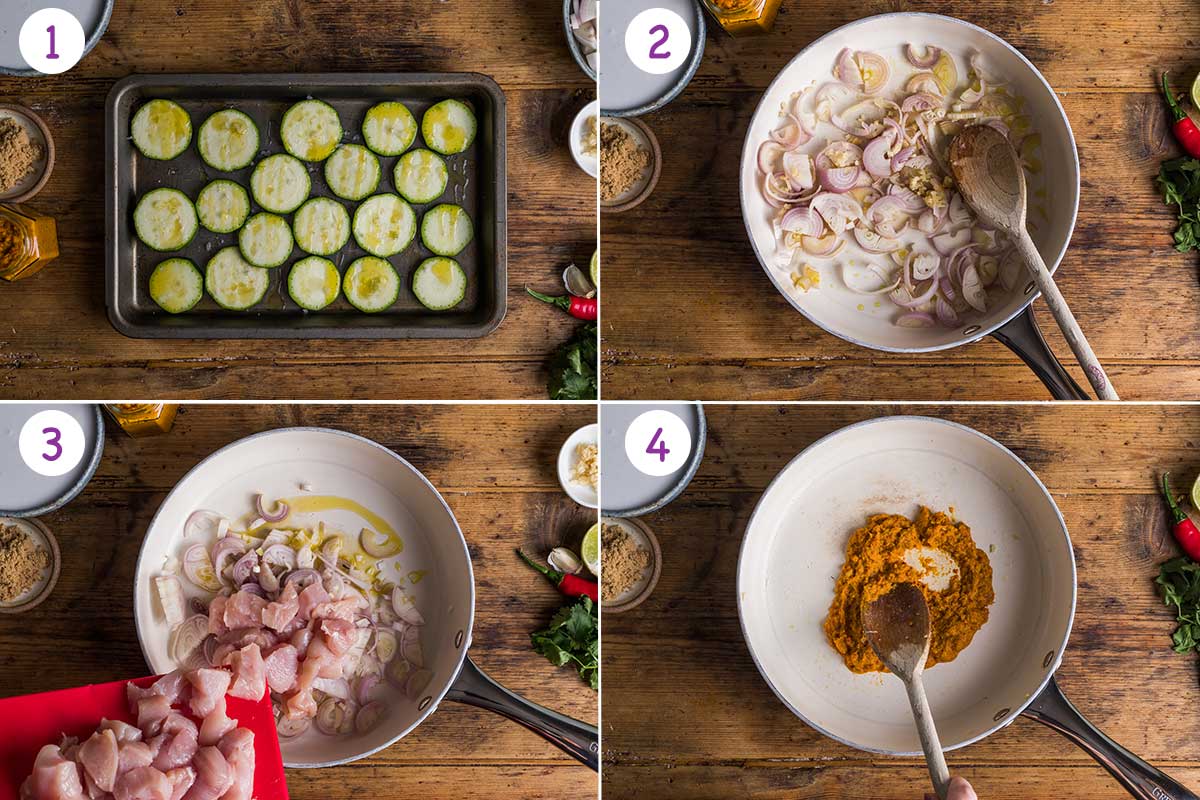
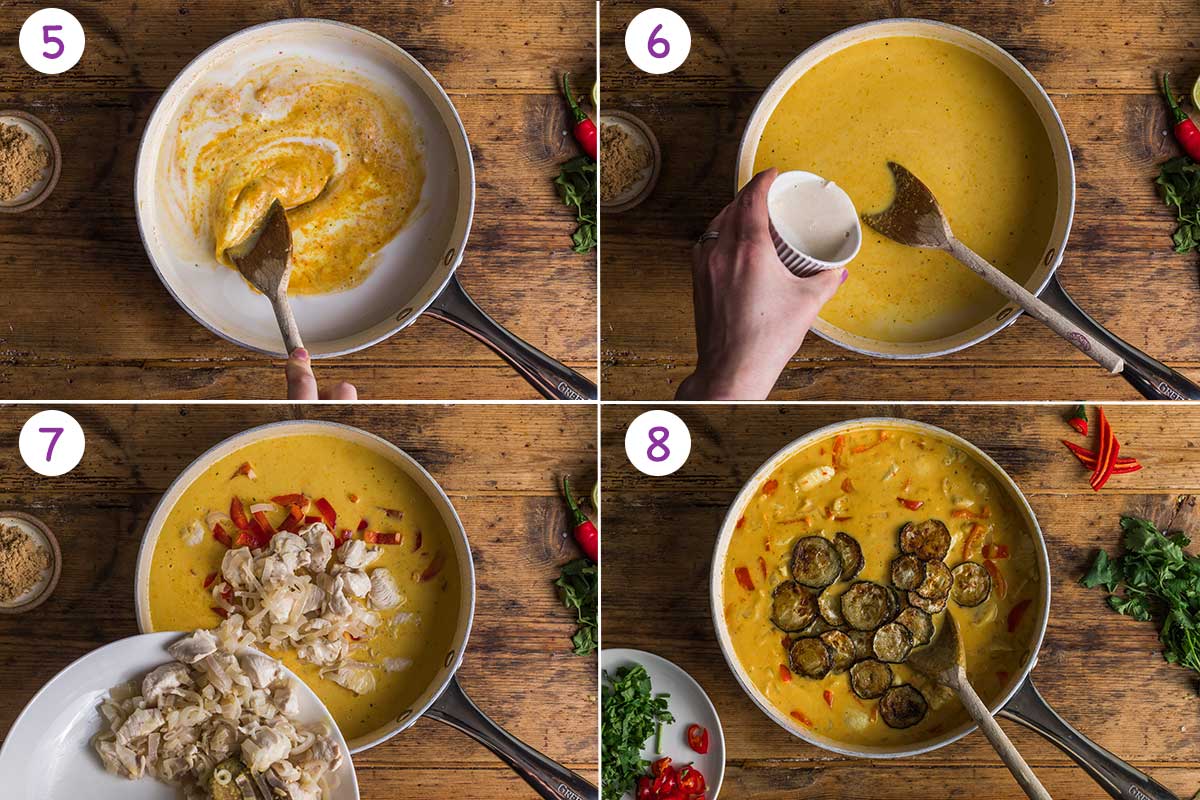
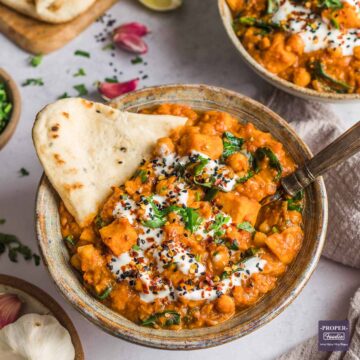
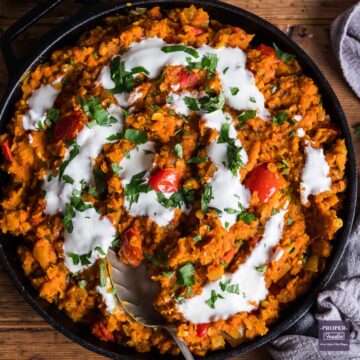
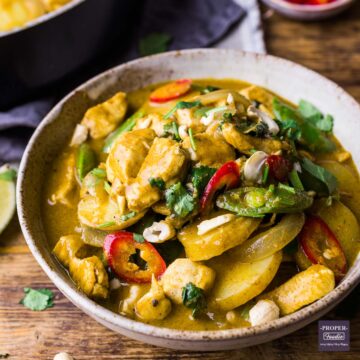
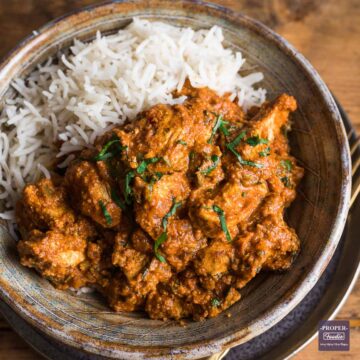
Northern Home
Great recipe! Easy and delicious and some great advice. Thank you
Debbie Jones
Thanks so much for your lovely comment. I'm glad to hear that you enjoyed the recipe and found the tips useful. Debbie x
The Novice
I love Thai curries too! I've never made a red one before though - I also usually stick to green curries. P.S. Thanks for your tips on how to thicken a curry. Super helpful!
Debbie
Hi Cassidy! Thanks so much for visiting! Hope you enjoy a change up to a red curry a little more often now 🙂 and so glad the information is of use to you!! 🤗🤗